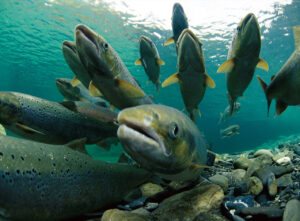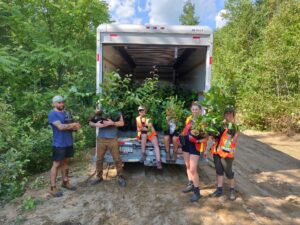 As you inspect the grilse (1 sea winter fish) returns on the DFO web site you will see that grilse numbers were as low as 25% of 2004-2008 averages in many NB rivers, and this suggests that conditions were quite harsh (cold) in the Labrador Sea feeding grounds last winter.
As you inspect the grilse (1 sea winter fish) returns on the DFO web site you will see that grilse numbers were as low as 25% of 2004-2008 averages in many NB rivers, and this suggests that conditions were quite harsh (cold) in the Labrador Sea feeding grounds last winter.
While the marine environment was hard on fish from other NB rivers, the severity of the population decrease in the Saint John system was away out of proportion to that in other rivers with grilse numbers being 7% at Mactaquac and 4% on the Nashwaak of 2004- 2008 averages.
The crash of populations in the Saint John system in the mid 1990s was also much more severe than the declines experienced in the other NB rivers, and that “more severe decline” corresponded with the rapid rise of sea lice populations generated in Bay of Fundy salmon farms.
Natural conditions have salmon smolt moving out into the open ocean in late spring, long BEFORE the sea-lice-laden adults arrive to ascend their home rivers to spawn – so there are few sea lice eggs and sea lice juveniles available to infest the seaward migrating smolts, however with the advent of salmon aquaculture in the Bay of Fundy, sea lice eggs and sea lice juveniles are constantly being released into the water column unless they are almost completely controlled with pesticides.
When Bay of Fundy salmon farms gained almost complete control of sea lice using SLICE (Emamectin Benzoate) for a few years — Saint John river system salmon populations began to recover, with spectacular increased returns on the Nashwaak River (no dams here). Nashwaak returns seen on the website (above) are generally underestimates due to periods when the counting fence at Durham Bridge is not operational due to high water events, however numbers at the Mactaquac Dam on the main stem of the Saint John River, near Fredericton, are accurate as every fish moving upstream is counted there.
So here we are again. The salmon farming industry in the Bay of Fundy has recently lost almost complete control of sea lice because the parasites have developed resistance to SLICE, the only really effective pesticide that exists – and we are again faced with severe salmon population decreases in the Saint John River system.
It is doubtful that we can have robust Atlantic salmon populations in the Saint John system as long as the salmon farms are generating massive numbers of sea lice which drift in the water column to meet seaward migrating smolt in the spring. Reports from other areas around the Atlantic Ocean suggest that salmon smolt mortality approaches 100% when they acquire 9 or 10 sea lice during their outward migration.
If you have questions, comments or would like to discuss this further, feel free to contact me via email.
-Peter Salonius
Photo by Paul Nicklen ©2007 National Geographic Society

